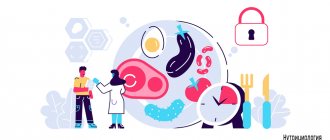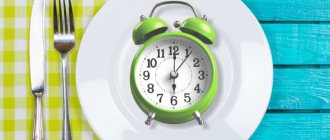Cleansing the body of harmful substances is an issue that is receiving a lot of attention today, not only by scientists, but also by ordinary people. And what people don’t do, seemingly for their own good: they drink purified juices, go on detox diets, drink huge amounts of water, do enemas, use all kinds of medications and do magic over the stove, looking at pieces of paper with folk recipes.
But is all this effective? Of course, proper nutrition, drinking regimen, buckwheat and oatmeal are useful, but you should not expect that they will remove toxins and waste from the body much faster than regular nutrition. What to do? Here’s what you can do: you can turn to a still not very well-known, but very effective method of cleansing your body, which, among other things, you can also control yourself.
This method consists of... self-eating! Yes, yes, you read it right - in self-eating (or self-cannibalism). But it’s better to call it the scientific term “autophagy.” If you wish, you can teach your body to get rid of harmful substances on its own. But let's take our time and tell you about everything in order.
What kind of self-eating is this?
The concept of “autophagy”, if translated from Greek, means “self-eating”. The essence of this process lies in the utilization (processing) of macromolecules and organelles (components necessary for the existence of cells) in cellular compartments (separate areas), which are formed by the fusion of lysosomes (cellular organelles) with autophagosomes (structures formed around damaged cells). But this is a purely scientific definition.
To put it simply, autophagy occurs when cells adapt to harsh conditions. If there are not enough nutrients coming from outside in the body, the cell gives up some of its organelles and macromolecules to produce monomers - elements suitable for the synthesis of new proteins, nucleic acids, carbohydrates and lipids.
The process of autophagy is very important for removing damaged elements from cells, such as protein aggregates. As this process progresses, damaged organelles and macromolecules located in the cytoplasm enter a special compartment where they are broken down into small molecules. And these small molecules, if there is a lack of energy and starvation, become building material from which new organelles and biopolymers (proteins, nucleic acids, polysaccharides and other elements necessary for the functioning of the body) are formed.
Autophagy accompanies the vital activity of all normal cells under normal conditions. However, excessive autophagy can lead to cell death, which is why today it is considered a form of programmed cell death, along with processes such as necropotosis and apoptosis.
And finally, to put it very simply, we can say this: over time, “garbage” accumulates in every cell of our body, and autophagy contributes to its processing and, as a result, rejuvenation of the body. Everything is elementary. “But how can that be? Why isn't anyone talking about this? Why don’t the media trumpet it loudly?” - quite reasonable questions. But they talk about it, and the media is also well aware of it. The simply stunning results that autophagy leads to have become known only recently.
What does the concept of protophagy give us?
The introduced concept of protophagy is interesting not only as a bare theory, but can also be useful in practice. For example, bacteria are widely used in biotechnology today, and manipulation of protophagy processes may provide a way to maintain bacterial culture stability on an industrial scale. Thus, protophagy activators should improve the quality of crops by activating natural mechanisms for eliminating weakened and damaged microorganisms.
Another important area of application of protophagy may be medicine. Today, bacterial resistance to antibiotics is one of the key pharmacological problems. Instead of killing individual bacterial cells (as is done today with antibiotics), we can concentrate on disrupting bacterial communities as a whole. Such methods are already being developed—for example, blockers of bacterial “quorum sensing,” which are aimed specifically at disrupting intercellular signaling in bacterial colonies in order to make them vulnerable to the human immune system [10], [11]. And although this topic is just developing, and there are still more questions than answers, the general vector of work shows that disruption of communication between individual bacteria has every chance of becoming the therapy of tomorrow. In this context, protophagy activators will help to destroy the protective barriers of the bacterial colony and make it vulnerable to the host immune system.
The discovery of autophagy: the research of Christian de Duve
In general, autophagy, as a method of delivering cell cytoplasmic material into lysosomes for subsequent degradation, has been known since 1963. Then this term was introduced by the discoverer of lysosomes, the Belgian biochemist Christian de Duve. And here we need to return to scientific terminology again - this is very important for the history of discovery.
As a result of research, de Duve discovered that during autophagy in the cytoplasm, the process of formation of autophagosomes first occurs - vesicles that are surrounded by a double-layer membrane and which contain part of the cytoplasm and cellular organelles, such as fragments of the endoplasmic reticulum, ribosomes and mitochondria. Autophagosomes then combine with lysosomes to form autolysosomes. In them, under the action of lysosomal enzymes (hydrolases), organelles and macromolecules are degraded.
For these discoveries in the field of structural and functional organization of the cell, de Duve received the Nobel Prize in 1974.
What is it: a brief summary of the process
Intermittent fasting (aka PG, aka intermittent fasting (IG), aka Intermittent Fasting (or IF), aka Alternate day fasting, etc.) is a strategy for managing the timing of nutrients entering the human body, which globally consists of two stages :
- You don't eat for a certain period (~12-48 hours).
- You eat over a certain period (~8-24 hours), it is during this period that you eat your daily calories based on your goals (weight loss/maintenance/gain).
There are several versions of PG, but they all share a common principle: a period of hunger and a period of feeding (or feeding window).
This nutritional system became especially popular after 2016, in which a Japanese scientist received the Nobel Prize for (as many thought) proving that autophagy cleanses the body and is triggered by hunger. Let's dispel myths and misconceptions!
Further research on autophagy: the work of Yoshinori Ohsumi
And in the not so distant year of 2016, an outstanding Japanese scientist, molecular biologist Yoshinori Ohsumi, began to study autophagy in yeast cells, using a genetic approach. As a result, he found more than a dozen genes, inactivation (complete or partial loss of activity by a substance) of which caused autophagosome defects. The found genes were studied and cloned.
Further research into the functioning of the protein products of these genes made it possible to elucidate the molecular mechanisms of the appearance, course and regulation of autophagy. By the way, the genes Osumi found were called ATG (from the English “autophagy-related genes”), and to date more than thirty of them have been found.
Yoshinori Ohsumi demonstrated that autophagy is a programmed process, i.e. a process that is encoded in the genome. If you turn off or mutate the genes necessary for autophagy, this process will become impossible. But what does all this have to do with human health from the point of view of the average person?
The fact is that homologous genes in yeast and mammals have noticeable similarities. The protein products of such genes are distinguished by a small number of amino acid substitutions. If a certain gene in yeast is responsible for autophagy, then there is a high probability that a similar gene will perform similar functions in humans.
The genetics of autophagy had to be studied in yeast cells - it is much simpler. However, along with research into the mechanisms of autophagy in yeast in his laboratory, Ohsumi discovered homologs of some yeast ATG genes in mammalian cells. Studying the functioning of their proteins, which are encoded by these genes, showed scientists that the differences in the molecular mechanisms of autophagy in such completely different organisms as yeast and humans are negligible.
After some scientific manipulation and subsequent discovery of new forms of the protein, Ohsumi's team created a transgenic mouse that converts the genetic information from the gene into a recombinant protein. This made it possible to visualize autophagy using fluorescence microscopy and study its kinetics and intensity in different mouse organs during fasting. And the very next studies, for which mice were created with the ATG gene disabled, helped to find out that autophagy is of great physiological importance for the development of mammals, including humans.
In 2016, Yoshinori Ohsumi was awarded the Nobel Prize for his discovery of the mechanisms of autophagy. Here's a short video about it:
And in 2022 he was awarded the Medical Breakthrough Award. And this is no coincidence, because his work is capable of bringing the entire world of medicine to a fundamentally new level. But before we look at the benefits of autophagy for human health, we need to say a few words about its types.
Afterword
The main question that may arise after reading this article is whether it is really necessary to introduce a new term - protophagy - to describe well-known facts? In our opinion, expanding the concept of autophagy and introducing the term “protophagy” is necessary and useful.
The biosphere in a certain sense resembles a fractal, where each subsequent level repeats the previous one. Similar processes are similar to each other not only externally - they all have similar causes and principles of regulation. The concept of protophagy, which unites disparate prokaryotic processes together, allows us to generalize and better understand the deep mechanisms that regulate the life of prokaryotic colonies. This provides undeniable benefits for the biotechnology and medicine of tomorrow.
Whether the term “protophagy” will catch on and whether other scientists will find it useful remains to be seen. We outlined what we thought was important in an article published in the journal Autophagy [12]. If microbiologists accept these generalizations and find them useful, we will be very pleased. If the citation rate of our article does not break records, it means that we have fallen into medieval scholasticism and overestimated the significance of our own inventions. In any case, it was worth presenting this work to the esteemed public - after all, protophagy is a special case of autophagy in the bacterial world and follows the same laws as its other manifestations - be it autophagy in a eukaryotic cell, trophic chains in the biosphere, or fasting according to the fashionable method before the beach season, which, by the way, is already around the corner.
Based on an original essay in Autophagy [12].
Types of Autophagy
Modern scientists distinguish three types of autophagy: micro- and macroautophagy, as well as chaperone autophagy:
- Microautophagy. Fragments of cell membranes and macromolecules are captured by the lysosome. Thanks to this, when there is a lack of building material and energy (for example, when a person is starving), the cell is able to digest proteins. However, microautophagy mechanisms are also activated under normal conditions.
- Macroautophagy. Part of the cytoplasm (most often that which contains organelles) is surrounded by a membranous compartment. As a result, this part is separated from the rest of the cytoplasm by two membranes, turning into autophagosomes. They combine with lysosomes and form autophagolysosomes, where organelles and other contents of autophagosomes are digested. With the help of this type of autophagy, cells can get rid of organelles that have “served their useful life.”
- Chaperone autophagy. Partially denatured proteins are purposefully transported from the cytoplasm into the lysosome cavity for subsequent digestion. This type of autophagy (by the way, it is described only for mammals) can be initiated by stress, for example, severe physical activity or fasting.
And now we can finally move a little away from the specific scientific terminology, and talk in “human” language specifically about the effect of autophagy on the human body.
General information
So, autophagy - to understand what it is, you need to turn to the ancient Greek language. Auto in translation means “himself”, phagos - “is”. The term is literally defined as self-criticism.
It is a mechanism for influencing old cells that have completed their functions. Cellular components, including organelles, proteins, cell membranes, are decomposed and recycled.
A process identical to autophagy is called aptosis - cell death, which is activated after a certain number of division cycles. Despite the reassuring sound, the process ensures the health of the human body.
The main difference in the mechanisms is that during autophagy the cell does not die completely; obsolete components are replaced with updated ones. Old formations are removed, enter the lysosome, and are broken down under the influence of enzymes.
Benefits of autophagy for humans
The positive role of autophagy for human health, of course, outweighs the negative, otherwise it would not have received so much attention. But in order to adequately imagine its beneficial effects, you need to remember something about the nature of its appearance.
Before technologies for growing food in almost any conditions and storing it for a long time, depending on the climate, during certain periods (early spring and winter) people had to limit their diet. At the same time, they felt great, and there was no need to talk about the widespread spread of such serious diseases as Alzheimer's disease, cancer or tuberculosis. And as you and I have already found out (even if we only talked about it in passing for now), cells begin to digest “waste” material, waste and toxins precisely during fasting.
According to the same scientific research (as well as the process of evolution), the positive role of autophagy is undeniable, because a low-calorie diet increases human life expectancy by approximately 30-40%. Dietary restrictions, from a scientific point of view, activate the body’s production of special genes that are responsible for longevity and contribute to the continuation of life even in conditions of relatively poor nutrition.
There is every reason to believe that autophagy is an internal program for processing harmful substances in the body. It improves the body's efficiency by ridding it of non-functioning particles, stopping the development of cancer cells and preventing metabolic dysfunctions such as diabetes or obesity.
There is also evidence that autophagy has important implications for the control of the immune system and inflammatory processes. Remember those same mice with a non-functioning ATG gene - they experienced drowsiness and obesity, brain disorders and elevated cholesterol levels. And we all know that such “features” can lead to the most serious and not at all joyful consequences. And, since we mentioned cancer, we should also talk about its connection with autophagy.
Doctors' opinions
Therapeutic fasting, which lasts exactly one day, is supported and recognized by doctors. However, some enthusiasts and lovers of magic weight loss pills increase the period of abstinence from food to several days, which causes indignation among nutritionists. Such neglect of health is fraught with the launch of irreversible destructive processes.
Doctors pay attention to the fact of competently entering and exiting a one-day fast, which will cleanse the body of waste and toxins, activating the process of autophagy.
Autophagy and cancer
Scientists at the University of Pennsylvania, searching for an effective cancer treatment, have taken another important step thanks to data on autophagy. Now they can rightfully say that the creation of a truly working method of combating cancer is not far off.
In particular, the researchers worked with the lysosomal enzyme PPT1, and with its help they were able to develop a drug that showed good results in the fight against diseases such as colorectal cancer, pancreatic tumors and melanoma. But so far, all experiments, again, have been conducted on mice.
This same PPT1 enzyme is responsible for two important processes in the life and growth of cancer cells. The first process is autophagy itself, which allows cancer cells to survive, and the second is the target of rapamycin (mTOR), which is responsible for the uncontrolled growth of tumors. By the way, the drugs that have been used in recent years are also aimed at the target of rapamycin, but their difference is that they do not take into account the process of autophagy, which is why there is no way to influence the resistance of cancer cells to treatment.
Now, thanks to the discoveries of Yoshinori Ohsumi, who showed that it is possible to “force” cells to eat themselves, get rid of damaged particles and receive new resources for restoration, the situation has changed radically. Scientists have discovered that mTOR can also use autophagy to provide itself with resources, and when exposed to the PPT1 enzyme, the activity of the former is suppressed, and the autophagy process is blocked. This is the reason why a cancerous tumor begins to respond to anticancer therapy.
However, all these advantages of autophagy are only one side of the coin. It is very important to understand and always remember that it can have a negative impact on the body’s condition. True, this only applies to a certain category of people.
What inhibits the autophagy mechanism
Some substances have been found to reduce autophagy in animal or cell studies, but this does not mean they should be avoided in humans. This section of the article should not be used as a reason to take or avoid a specific substance or medication. Talk to your doctor before taking any new substance, and under no circumstances stop taking a medication without first checking with your doctor.
Biological substances
Editorial Disclaimer CODE OF LIFE
- Eugenol , a phenolic acid found in cloves ( Syzygium aromaticum
), was identified among 86 traditional Chinese medicines as having the strongest ability to reduce autophagy. () - Bafilomycin A1 , a macrolide antibiotic derived from Streptomyces griseus
has been reported to inhibit autophagy. () - Elaiophylin has been identified as a microbial compound from North China Pharmaceutical Group Corporation that has good ability to reduce autophagy. ()
- Oblongifolin C , a phenolic acid from the Asian tree Garcinia yunnanensis
, inhibits autophagy and has been described as having antitumor properties. () - Matrine , an alkaloid found in plants of the genus Sophora, is an inhibitor of autophagy (via modulation of the lysosomal process). ()
Medications
- Wortmann()
- 3-methyladenine ()
- Spautin-1 ()
- Clomipramine ()
- Lucanthone()
- Chloroquine ()
The information on this site has not been evaluated by any medical organization. We do not seek to diagnose or treat any disease. The information on the site is provided for educational purposes only. You should consult your physician before acting on information from this site, especially if you are pregnant, nursing, taking medications, or have any medical condition.
Rate this article
Average 4.7 Total votes (14)
Autophagy is harmful to humans
Before you decide to start and stimulate the autophagy process in your body, be sure to make sure that you do not have:
- Chronic diseases (in particular, gastrointestinal diseases)
- Gastritis
- Ulcers
- Deviations in body weight (cases when it is below normal)
- Immune deficiency
- Diabetes
- Coronary heart disease
- Depression
- Hypotension (low blood pressure)
- Mental disorders
In addition, activating autophagy is strictly prohibited for women who have problems with fertility and lactation, pregnant women and people taking medications that are incompatible with fasting. If you neglect these contraindications, you can seriously worsen the condition of your body, aggravate existing ailments and seriously undermine your health. Otherwise, according to scientists, autophagy is a completely safe way of cleansing and rejuvenation. No less pleasing is the fact that you can launch it yourself.
Adviсe
Brief recommendations for organizing fasting days that will help optimize the process:
- Conducting weekly fasts on the same day of the week will help the body adapt to the regime;
- support from those around you on this day will not be superfluous. It is better to warn your loved ones in order to exclude planning trips to a restaurant and additional culinary temptations;
- do not allow exceptions or concessions in order to get maximum results;
- get busy with something or a favorite pastime so as not to get hung up on hunger;
- organize the process: prepare, enter correctly, exit the process.
Preparation
Preparation is the foundation of any process and ensures success in achieving your goals. This will help:
- Avoid drinking alcohol for 2-3 days;
- make sure there are no contraindications;
- reduce the number of servings of food per day;
- you should not overeat in the evening and before bedtime, so as not to turn therapeutic fasting into a typical fasting day after the belly festival;
- get ready for fasting.
Entrance
The optimal time is considered to be the morning or immediately after breakfast. This could be a dish prepared according to the principles of a healthy breakfast or your favorite fruit. Breakfast is the best time to start, because the next morning you can enjoy your favorite ingredients and drinks.
The evening time of entry is fraught with the desire to eat, but instead, preference should be given to a light dinner and lean foods.
Exit
It is important to know how to break fasting so as not to harm the body:
- A gradual increase in portions will help to avoid overloading the gastrointestinal tract;
- for the first meal, choose light foods and dishes: smoothies, fruit or vegetable salads;
- no overeating! One day of not eating is not a reason to praise yourself with a cake or a big pizza. It is recommended to accompany the recovery from a one-day fast on water or dry food for one day after fasting, adhering to the principles of fractional nutrition.
How to trigger autophagy: autophagy and fasting
Most modern people, by abusing high-calorie, unhealthy and unhealthy foods, themselves make it so that the autophagy process simply does not start. And this, if you think about it seriously, actually leads to a decrease in immunity, accelerated aging and even the development of all kinds of mutations at the cellular level.
If you force the cells to starve, they will automatically begin to use external resources to function, get rid of harmful substances and recover. But constant malnutrition can lead to degenerative processes, because autophagy simply will not stop. Therefore, it makes sense to partially return to the ideas of therapeutic fasting.
In total, there are several types of it, but we are interested in exactly two - intermittent and prolonged fasting. They were described in detail by the famous Italian-American biogerontologist and cell biologist Valter Longo, who spent many years researching the effects of fasting and limited diet on life expectancy and health (keep in mind that when we talk about fasting, we mean specifically refusing food, but not from water).
Intermittent fasting
The essence of intermittent fasting: a day without food, followed by 1-2 days of normal nutrition.
Scientific research suggests that intermittent fasting activates neural connections and improves cognitive function, lowers blood pressure and heart rate, increases tissue sensitivity to insulin, delays the appearance of tumors, prevents inflammatory diseases, improves blood regeneration, and increases the number of white cells in the blood. and the immune system is stimulated.
Experiments conducted with the already mentioned mice have confirmed the benefits of intermittent fasting as a prevention of neurodegenerative, cardiovascular and tumor diseases, as well as diabetes. And subsequent observation of people showed that it normalizes blood pressure and glucose levels, reduces the number of markers of inflammation in those suffering from bronchial asthma.
Of course, you should not give up the dietary norm that is popular today, often and little by little, but you still need to keep in mind that this regimen increases the production of insulin, causing cells to lose sensitivity to it, and this can lead to type 2 diabetes mellitus . So even this norm (eating little and often) is useful to dilute from time to time with periodic fasting.
Prolonged fasting
The essence of prolonged fasting: 2-3 (sometimes more) days without food, followed by at least 7 days off before the next 2-3 days of fasting.
This is where scientific research comes into play again. They say that prolonged fasting leads to activation of autophagy, increased sensitivity of tumors to therapy, and improved regulation of insulin (and insulin-like growth factor 1) and glucose levels.
Also, fasting according to this scheme reduces liver weight and the number of leukocytes in the blood. But resumption of nutrition produces powerful regeneration processes, both in the immune system and in the liver. For this reason, prolonged fasting is allowed only under the supervision of a specialist. In this case, special care must be taken by people over 65 years of age, because At this age, a lack of protein can cause unwanted muscle loss.
Here are some more tips for safely restricting your diet:
- Even if you completely stop eating for a day or more, you need to drink enough water.
- A very convenient and safe way to stimulate autophagy is to avoid 1-2 meals (for example, dinner and/or lunch) 2-3 times a week
- When simulating intermittent fasting for 5 days (another tip from Valter Longo), you need to eat no more than 100 calories on the first day and 500 calories on the remaining four days.
And, of course, speaking about diet, we could not miss the question about the correctness and incorrectness of nutrition in general. We've all heard a hundred times already that you can't eat after 6 p.m. And from the perspective of new data obtained on autophagy by Yoshinori Ohsumi, this statement is again confirmed, but the question of the benefits of frequent split meals remains open.
Let's return to our mice, which provide significant assistance in research to improve human health. Experiments showed that with the same number of calories per day, mice that ate at intervals of 12 hours “showed” better results than those that ate little and often. Thus, in the mice of the first group, there was an improvement in circadian rhythms and they slept better, but most importantly, they stopped developing and even reversed metabolic diseases.
This once again suggests that if suddenly during the day you do not have time to eat, having the opportunity to eat only in the morning and/or evening, you should not be upset, but rejoice, because this is how you trigger autophagy for the benefit of your body. Likewise, eating intermittently for 12 hours or more activates autophagy. No matter how strange it may sound, this diet helps reduce fat mass without losing muscle mass, and reduces blood glucose and cholesterol levels. And fasting for more than 13 hours from evening to morning minimizes the risk of developing breast cancer.
But here we want to note: under no circumstances should autophagy be perceived as a medicine. For the most part, this is the prevention of various ailments, but not their treatment. Keep this in mind and do not draw false conclusions.
By the way, you can watch the video “Fasting from different angles/Fasting as the basis of life,” from which you can learn many interesting facts about fasting and its effect on the body:
If you don’t want to starve at all, there is a way to stimulate autophagy processes without restricting yourself in food. To do this, you need to include in your diet some specific foods that contain substances that activate the necessary processes. Such products are (substances are indicated in brackets):
- Pomegranate, strawberry and raspberry juice, as well as red wine aged in oak barrels (urolithin A)
- Grapefruit, cheese and mushrooms (spermidine)
- Bitter cucumbers (cucurbitacin)
- Soybean (dioscin)
- Red grapes (resveratrol)
- Curry (curcumin)
- Cocoa and green tea (catechin and epicatechin)
- Ginseng root (magnoflorin)
- Brown rice (gamma-tocotrienol)
- Walnuts and peanuts, mushrooms, barley, legumes, oats, bread and white meat (vitamin B3)
Also take note of oatmeal, fish oil, quince, olive oil, sour cream, spinach, cabbage, lingonberries, kefir and eggs - the substances contained in these products stimulate cell renewal.
Among other things, it is also noteworthy that the process of autophagy is triggered not only by fasting and proper nutrition, but also by physical activity and sports. But for this to happen, you need to adhere to certain principles.
Reviews and results
So, reviews of the most common type of fasting for weight loss in women 16/8:
Hello. I won’t write a long review - I lost 6 kg on ig.
I don’t know, everyone praises me so much, but I lost it 2 days later and overate so much that I became physically ill and vomited











